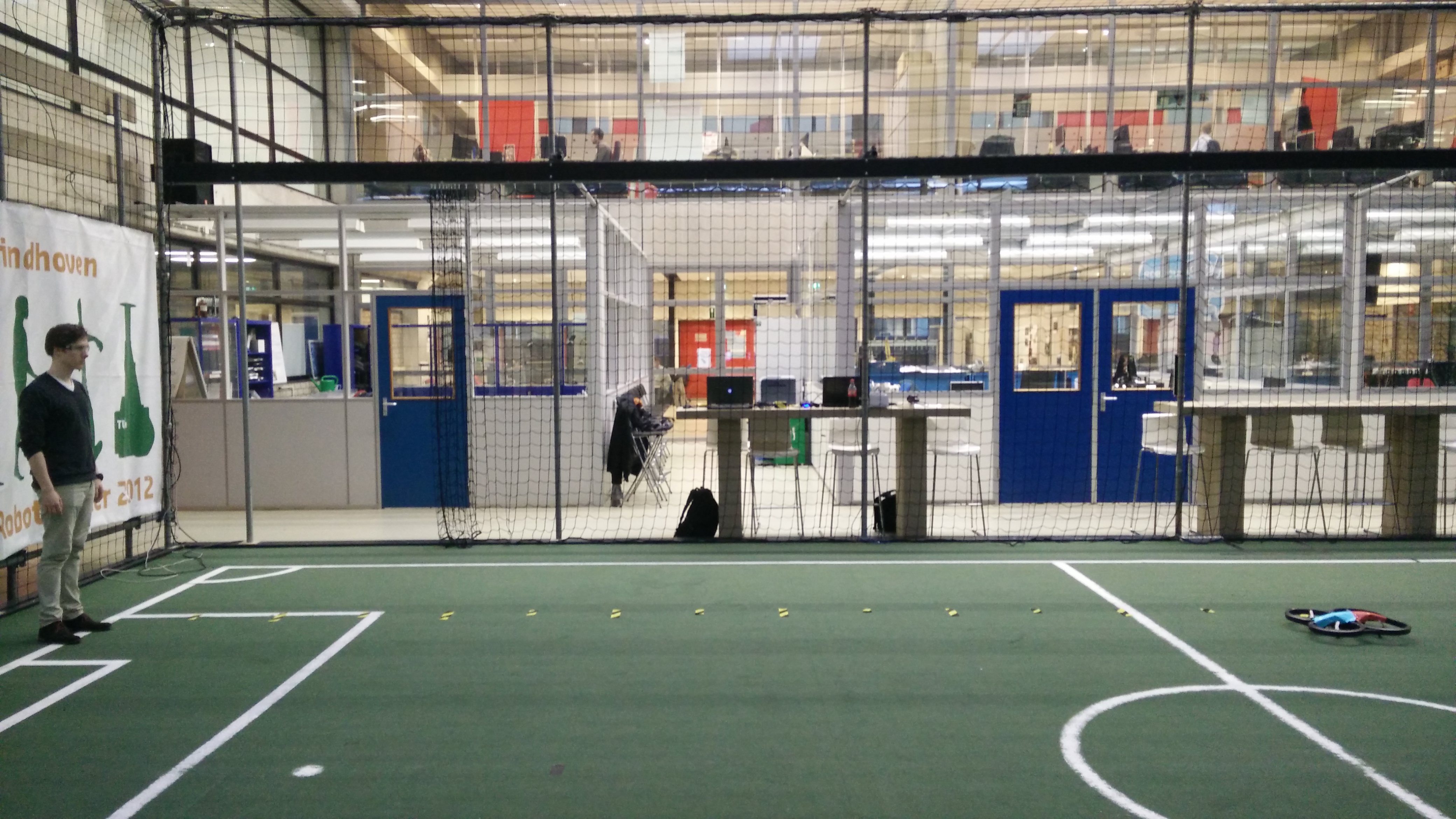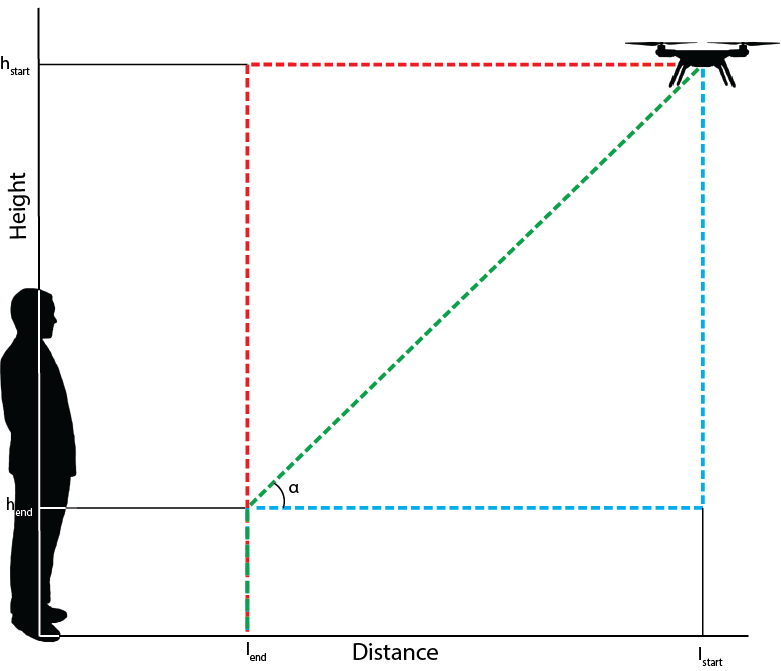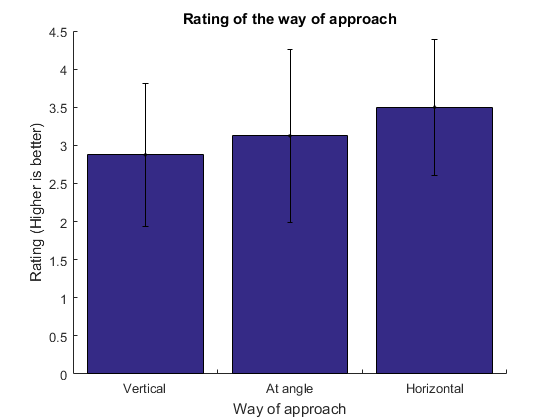PRE2015 3 Groep2 week5
Approaching Users
Experiment 1: Landing distance

The variable landing distance is about the distance that users are still comfortable with the drone around. The optimal distance that users like and the nearest distance that people are comfortable with drones around are determined with an experiment. The subject (an user) stands on a given spot (l=0). The distances 0.5, 1, 1.5…7 meters are marked with masking tape (distance to test subject) on the ground. The drone will start at a distance of 7 meters (= lstart) as seen in figure 1. The drone will approach the person at a steady speed of approximately v = 1 m/s. It does so at a height of h = 1 meter. Whenever the test subject feels like the current distance between him and the drone is the most comfortable distance to land, the test subject will give off a sign and the drone will be given the order to land (lend). The subject will redo the test to determine the nearest distance where he or she feels comfortable. Those distances are measured and rounded per 0.25m. The results are seen below.
| Experiment | Optimal distance (m) | Nearest distance (m) |
|---|---|---|
| 1 | 2.25 | 1.0 |
| 2 | 2.75 | 0.75 |
| 3 | 2.5 | 1.0 |
| 4 | 2.25 | 0.75 |
| 5 | 2.0 | 0.75 |
| 6 | 1.75 | 0.5 |
| 7 | 3.5 | 2.0 |
| 8 | 3.5 | 1.75 |
| 9 | 1.75 | 0.5 |
The mean value of the optimal distance is 2.47m with an standard deviation of 0.67. The nearest distance has a mean of 1.00m with an standard deviation of 0.53. These means give the landing distance from this experiment, the optimal landing distance is 2.5m with a nearest landing distance of 1.0m. The drone should be programmed to keep these distances as first option and starting point of the landing procedure.
Points of improvement
Though the experiment came with a clear conclusion, with a few outliners, some variables that might influence the results have not been touched upon. The experiment above gives a general idea for a distance to keep from the users, but does for instance not distinguish between different users. These differences may for example concern:
- Age
- Sex
- Experience (with drones)
- Length of the user
- And even general (in)security or character of the user
But also the drone itself can have influence on results:
- Approaching speed
- Size of the drone
- Appearance of the drone
- Noise
- Wind generated
Further research will have to point out to what extend these factors play a role in approaching users with drones.
Experiment 2: Way of approach

It's not only interesting to look at the best landing distance, but also at the way the drone approaches the user. For this, a distinction is made between three different situations. For a description of these situation see the list below and figure 2. In all these situations the test person is positioned at l = 0m. The drone starts at a distance lstart and height hstart.
- Situation A
- The drone flies horizontally to a certain distance lend then the drone lands vertically.
- Situation B
- The drone flies diagonally, at an angle α, to a certain point at distance lend and height hend. Then the drone lands vertically.
- Situation C
- The drones lowers itself vertically to a certain height hend. It then flies horizontally to a certain distance lend before it lands vertically on the ground.
For the distance lstart a distance of 8m is chosen. The ending distance lend is chosen according to the results of experiment 1 at roughly 2.5 meters.
After each test variation the test person is asked to rate the experience with the values very bad/bad/neutral/good/very good.
Point of improvement
During the experiment some notes ware mate about the quality of the experiment.
- The drone has been flown manually, so the same ways of approaching are different with each test subject
- The test group only exists of males
- The test group only involves three people, so the result aren't trustworthy
Results

| Experiment | Very bad | Bad | Neutral | Good | Very good |
|---|---|---|---|---|---|
| 1A | X | ||||
| 1B | X | ||||
| 1C | X | ||||
| 2A | X | ||||
| 2B | X | ||||
| 2C | X | ||||
| 3A | X | ||||
| 3B | X | ||||
| 3C | X |
As can be seen from figure x the best way of approaching the user is while flying at an angle. Flying horizontally to the user seems better at first, but since the error is bigger than it is at approaching at an angle it's safer to use this way of approaching.
During the experiment the landing distance of 2,5 meters is chosen, but maybe the way of approach differs at different landing distance. Do find this out their will also be looked at the likability of approaches with a landing distance of 1,5 and 3,5 meters.
Autonomous landing
Test setup
A major problem during the autonomous landing phase is that the drone needs to know where it is on the map it is creating. It's not wise to assume that the drone flies at a constant speed, since it doesn't. Doing so would create an error which can result in complete disaster.
Since the test setup has been moved inside, the situation created won't be realistic, but very controllable. Determining the location of the drone will be done with markers placed on the ground or objects which the drone can detected with its down facing camera. These markers will be placed 50cm from its neighboring marker.
In the first situation the system will be developed in a two dimensional world. Their will be height differences and the drone can be front- and backwards. No movement to the left or right will be possible. If the drone succeeds to land in such a randomized environment their will be looked at the second situation.
In the second situation a third dimension will be added, the left and right movement. This will be a more realistic environment, but far from the environment a drone will encounter in a real world scenario.
In both the situations their will only be objects the drone can detected from the height it uses to scan the environment. Since the markers are used to determine the location of the drone, they will be placed on a level surface. This could be an object or the ground. Their will also be enough space to land the drone in a user friendly way.